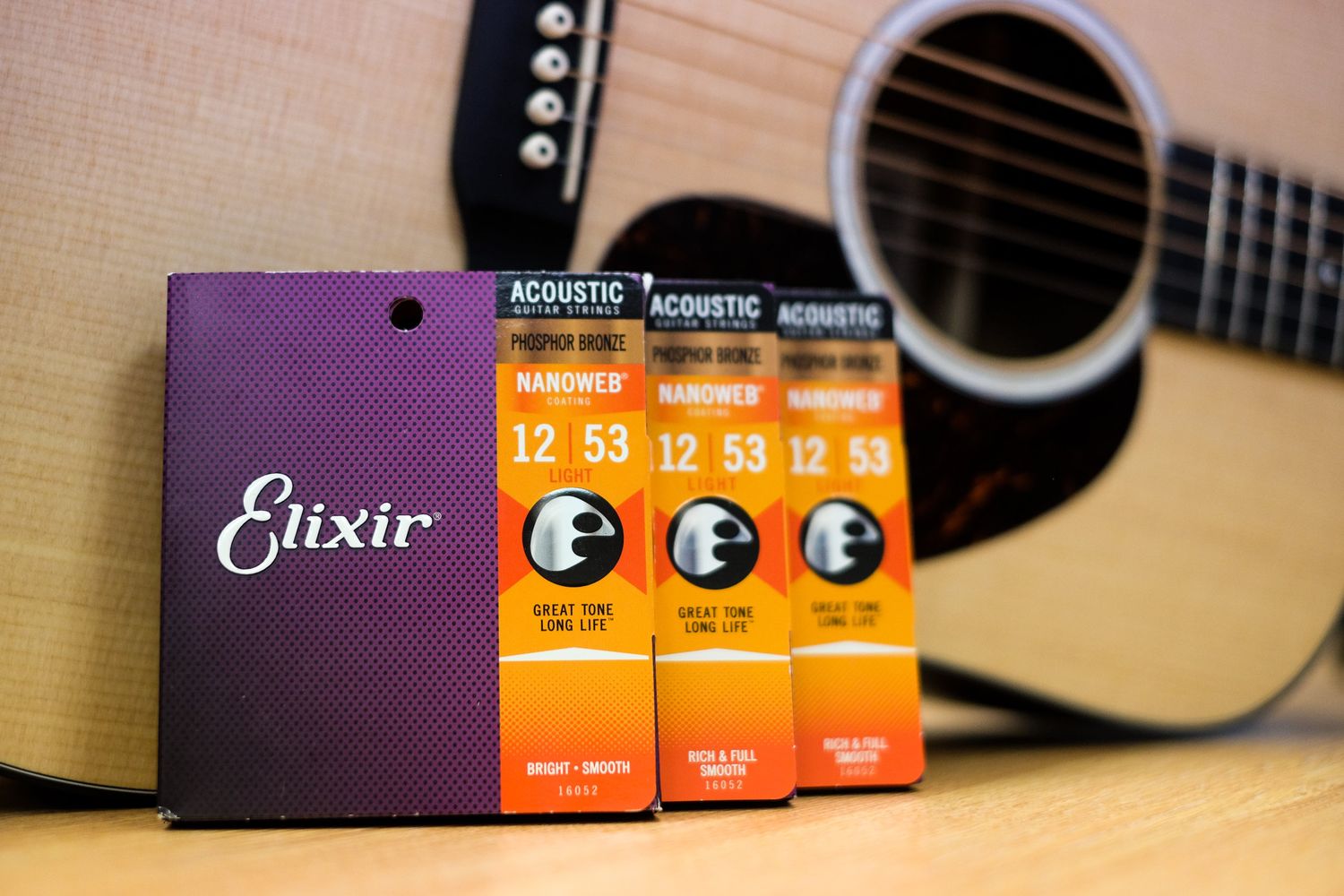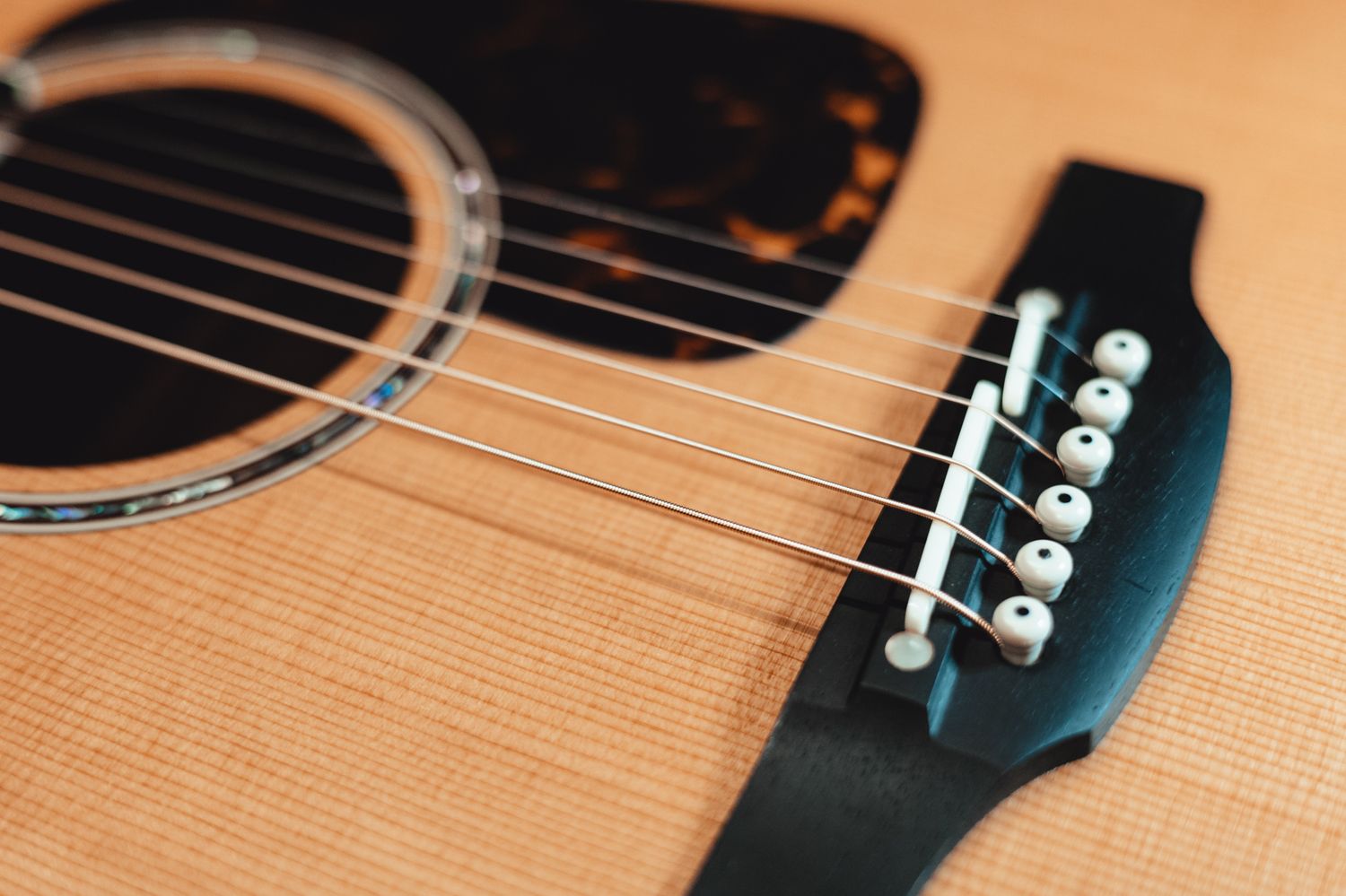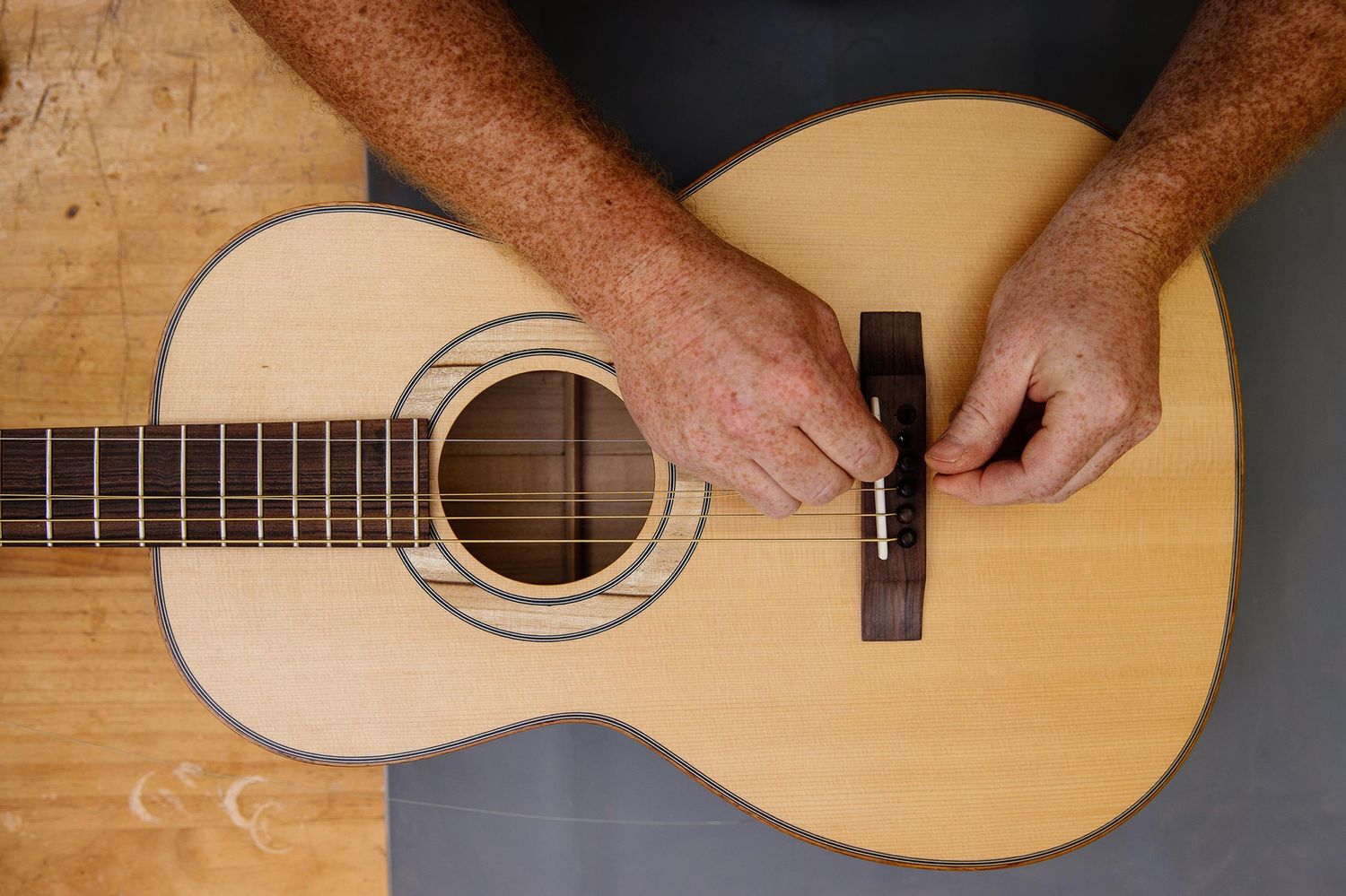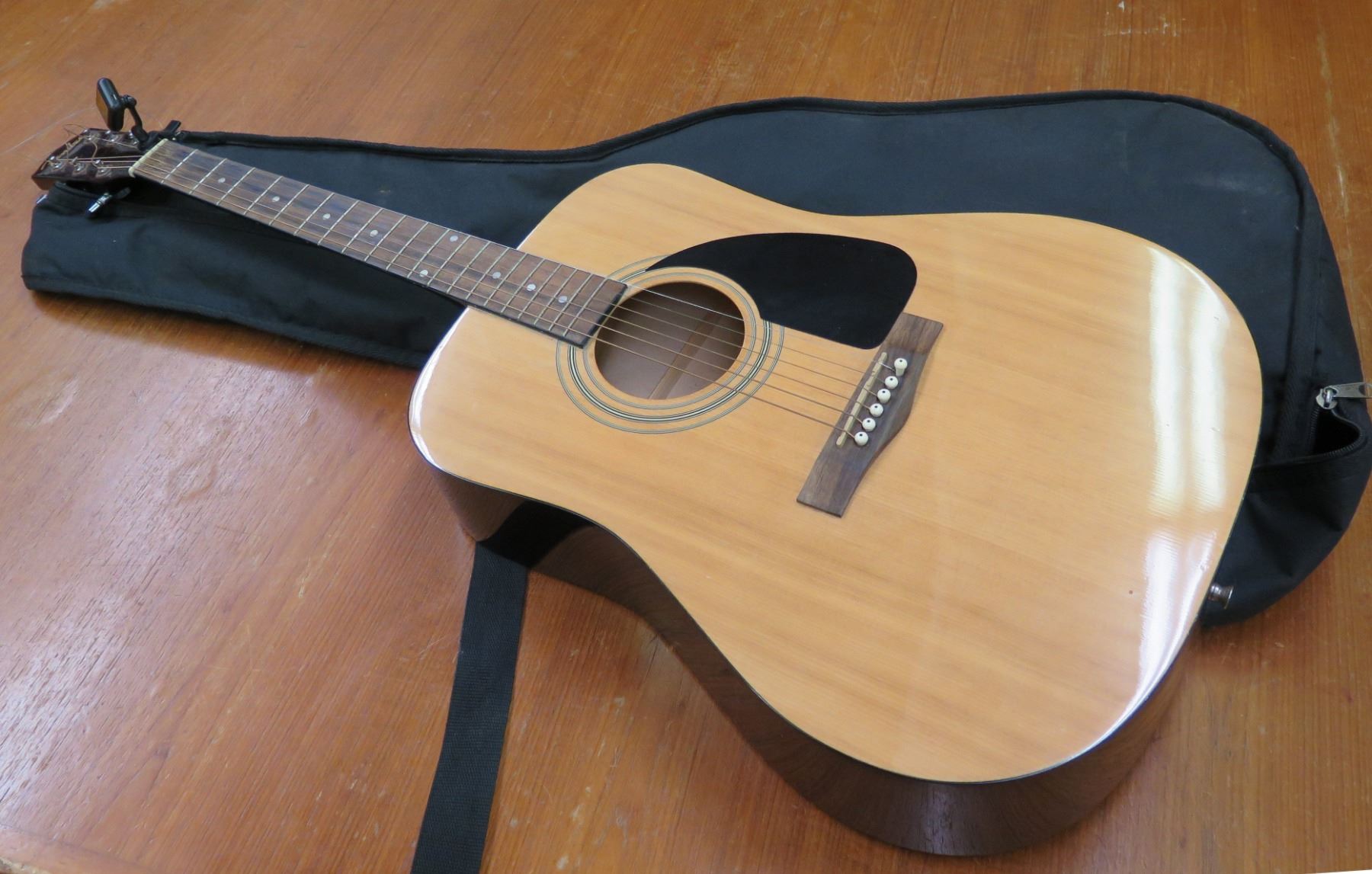Home>Instruments>Guitar>How To Choose The Right Acoustic Guitar Strings


Guitar
How To Choose The Right Acoustic Guitar Strings
Published: February 12, 2024
Learn how to select the perfect acoustic guitar strings for your instrument. Find the best guitar strings for your playing style and preferences.
(Many of the links in this article redirect to a specific reviewed product. Your purchase of these products through affiliate links helps to generate commission for AudioLover.com, at no extra cost. Learn more)
Table of Contents
Introduction
Welcome to the world of acoustic guitar strings! Whether you're a seasoned guitarist or just starting your musical journey, the strings you choose for your acoustic guitar play a crucial role in defining your sound and playing experience. Selecting the right strings can significantly impact the tone, playability, and overall performance of your instrument. In this comprehensive guide, we'll explore the essential factors to consider when choosing acoustic guitar strings, helping you make an informed decision that aligns with your musical preferences and playing style.
The process of selecting acoustic guitar strings may seem daunting at first, given the myriad of options available in today's market. However, with a bit of insight and guidance, you can navigate through the choices with confidence, ensuring that you find the perfect set of strings for your acoustic guitar. From understanding the different types of strings to considering factors such as gauge, materials, and coating, this article aims to demystify the world of acoustic guitar strings, empowering you to make a well-informed choice.
Whether you're drawn to the warm, mellow tones of phosphor bronze strings or the bright, crisp sound of 80/20 bronze, there's a set of acoustic guitar strings tailored to meet your sonic aspirations. By delving into the nuances of string construction, durability, and tonal characteristics, you'll gain valuable insights that will aid you in making a selection that complements your playing style and musical preferences. So, let's embark on this sonic journey together, unraveling the intricacies of acoustic guitar strings and uncovering the factors that will guide you toward the perfect set for your musical endeavors.
Understanding Acoustic Guitar Strings
Acoustic guitar strings are the lifeline of your instrument, serving as the primary medium through which sound is produced. Understanding the composition and function of these strings is essential for any guitarist looking to optimize their playing experience. Typically made from either steel or nylon, acoustic guitar strings come in a variety of thicknesses, or gauges, each offering distinct tonal characteristics and playability.
Steel strings, also known as “metal” or “phosphor bronze” strings, are favored for their bright, articulate sound and robust projection. On the other hand, nylon strings, commonly found on classical guitars, produce a mellower, more delicate tone, ideal for fingerstyle playing and classical music. It’s important to note that steel strings are not suitable for classical guitars, as they exert greater tension on the instrument’s neck and bridge, which are designed to accommodate the lower tension of nylon strings.
Furthermore, acoustic guitar strings are available in various winding configurations, with the most common being roundwound and flatwound. Roundwound strings feature a textured surface, providing enhanced grip for picking and fretting, while flatwound strings offer a smoother feel, reducing finger noise and fret wear. The winding of the strings also contributes to their tonal characteristics, affecting factors such as sustain, brightness, and warmth.
As you delve into the realm of acoustic guitar strings, you’ll encounter terms such as “coating” and “core type,” which play pivotal roles in determining the longevity and tonal profile of the strings. Coated strings, featuring a thin polymer layer, offer increased durability and resistance to corrosion, extending their lifespan and preserving their tonal clarity. Core types, including round core and hex core, influence the flexibility and tension of the strings, ultimately shaping their feel and responsiveness under the fingers.
By comprehending the intricacies of acoustic guitar strings, including their materials, winding styles, and additional features, you’ll be better equipped to make an informed decision when selecting the ideal set for your instrument. Whether you’re drawn to the bright, shimmering sound of phosphor bronze or the warm, balanced tones of 80/20 bronze, understanding the nuances of acoustic guitar strings will empower you to refine your sonic signature and elevate your musical expression.
Factors to Consider
When embarking on the quest to find the perfect acoustic guitar strings, several crucial factors warrant careful consideration. By evaluating these elements, you can tailor your string selection to align with your musical preferences, playing style, and the unique characteristics of your acoustic guitar.
- Tonal Preferences: One of the primary considerations when choosing acoustic guitar strings is the desired tonal profile. Whether you seek a bright, articulate sound with pronounced highs or a warmer, mellower tone with enhanced midrange, different string materials and constructions can help you achieve your sonic aspirations.
- Playing Style: Your playing style, whether it involves aggressive strumming, delicate fingerpicking, or a combination of techniques, will influence the ideal string gauge and tension for your acoustic guitar. Lighter gauge strings are often favored by fingerstyle players, offering increased flexibility and responsiveness, while heavier gauges provide enhanced projection and durability for vigorous strumming.
- Acoustic Guitar Type: The type and size of your acoustic guitar, such as dreadnought, concert, or parlor, can impact the suitability of certain string gauges and materials. Larger-bodied guitars may benefit from medium or heavy gauge strings to maximize volume and resonance, while smaller instruments may excel with lighter gauge strings for improved playability.
- Environmental Considerations: Environmental factors, including humidity and temperature, can affect the longevity and performance of acoustic guitar strings. In humid conditions, coated strings may offer increased resistance to corrosion, while in drier climates, non-coated strings can provide a more natural feel and tone.
- Budget and Longevity: While exploring acoustic guitar strings, it’s essential to balance quality and longevity with your budgetary constraints. Coated strings, though slightly pricier, can offer extended lifespan and consistent performance, making them a cost-effective choice in the long run.
By carefully weighing these factors and understanding how they interplay with your musical preferences and acoustic guitar characteristics, you can make an informed decision when selecting the perfect set of strings. Whether you prioritize tonal versatility, playing comfort, or durability, considering these elements will guide you toward a string choice that enhances your playing experience and resonates with your musical identity.
Types of Acoustic Guitar Strings
Acoustic guitar strings come in a diverse array of types, each offering distinct tonal characteristics, playability, and durability. Understanding the nuances of these string variations is essential for tailoring your instrument’s sound to suit your musical style and sonic preferences.
- Phosphor Bronze: Renowned for their bright, articulate sound and robust projection, phosphor bronze strings are a popular choice among acoustic guitarists. These strings, composed of 92% copper and 8% tin with a small percentage of phosphorus, deliver a balanced tonal profile with crisp highs and rich lows, making them versatile for various playing styles and musical genres.
- 80/20 Bronze: Also known as brass or bronze strings, 80/20 bronze strings are revered for their vibrant, pronounced highs and clear, ringing tone. Comprising 80% copper and 20% zinc, these strings offer a bright, lively sound that can add brilliance and articulation to your acoustic performances, making them well-suited for genres such as folk, pop, and country.
- Silk and Steel: Silk and steel strings feature a softer, more mellow tonal character, making them ideal for fingerstyle playing and gentler strumming. These strings, which incorporate a lower tension core and outer winding with silk fibers, produce a warm, intimate sound that complements acoustic guitars with a smaller body size, such as parlor or folk models.
- Nylon: Unlike steel strings, nylon strings are commonly found on classical and flamenco guitars, offering a softer, more delicate tonal palette. Nylon strings, known for their smooth feel and warm, rounded sound, are favored by classical guitarists and fingerstyle players seeking a mellower, more nuanced sonic expression.
- Coated Strings: Coated acoustic guitar strings, featuring a thin polymer layer that protects the windings from corrosion and debris, offer extended longevity and consistent performance. These strings are available in various materials, including phosphor bronze and 80/20 bronze, providing players with the option to enjoy the benefits of coating while tailoring the strings’ tonal characteristics to their liking.
By exploring the diverse spectrum of acoustic guitar strings, from the bright, shimmering tones of phosphor bronze to the warm, intimate sound of silk and steel, you can pinpoint the ideal string type that complements your musical style and acoustic guitar’s sonic personality. Whether you’re drawn to the vibrant articulation of 80/20 bronze or the gentle resonance of nylon, the world of acoustic guitar strings offers an abundance of options to enrich your sonic journey and elevate your musical expression.
Choosing the Right Gauge
When selecting acoustic guitar strings, the gauge, or thickness, plays a pivotal role in shaping the instrument’s playability, tonal character, and overall performance. Understanding the implications of different string gauges and their suitability for various playing styles is essential for tailoring your acoustic guitar to your sonic preferences and musical endeavors.
String gauges are typically categorized by the gauge of the high E string, expressed in thousandths of an inch. Common acoustic guitar string sets include light gauge (generally .012-.053), medium gauge (.013-.056), and heavy gauge (.014-.059), with variations available to accommodate specific tonal and playing requirements.
- Light Gauge: Light gauge strings offer increased flexibility and ease of play, making them well-suited for fingerstyle playing, intricate chord voicings, and bending techniques. These strings exert less tension on the guitar’s neck and bridge, providing a comfortable playing experience and facilitating expressive dynamics, particularly for players with a lighter touch.
- Medium Gauge: Medium gauge strings strike a balance between playability and projection, delivering a robust, full-bodied sound with enhanced sustain and volume. Ideal for strumming and flatpicking, medium gauge strings offer a versatile platform for a wide range of musical genres, from folk and blues to rock and country.
- Heavy Gauge: Heavy gauge strings are characterized by their increased tension and substantial, resonant tone. These strings are favored by players seeking maximum volume and projection, as well as enhanced durability to withstand aggressive playing styles. Heavy gauge strings can produce a bold, commanding sound, making them suitable for genres that demand a powerful acoustic presence, such as bluegrass and heavy strumming styles.
When considering the right gauge for your acoustic guitar, it’s crucial to assess your playing style, tonal preferences, and the specific requirements of your instrument. Lighter gauges may be preferable for beginners or players with a focus on fingerstyle and intricate fretwork, while medium and heavy gauges cater to those seeking a fuller, more robust sound and increased string durability.
Experimenting with different gauges can provide valuable insights into the tonal nuances and playability offered by each set, allowing you to refine your string selection to suit your musical expression. Whether you gravitate toward the responsiveness of light gauge strings, the versatility of medium gauge strings, or the commanding presence of heavy gauge strings, choosing the right gauge is a pivotal step in shaping your acoustic guitar’s sonic identity and optimizing your playing experience.
Coating and Materials
When exploring acoustic guitar strings, the choice of materials and the presence of coating significantly influence the strings’ tonal characteristics, longevity, and resistance to environmental factors. Understanding the impact of materials and coating options is essential for tailoring your string selection to meet your performance and durability requirements.
Acoustic guitar strings are commonly crafted from steel or nylon, with steel strings being the predominant choice for contemporary acoustic guitars. The two primary types of steel strings are phosphor bronze and 80/20 bronze, each offering distinct tonal profiles and sonic attributes.
- Phosphor Bronze: Composed of 92% copper and 8% tin with a small percentage of phosphorus, phosphor bronze strings deliver a balanced tonal spectrum with articulate highs and rich lows. These strings are revered for their versatility and projection, making them suitable for a wide range of playing styles and musical genres.
- 80/20 Bronze: Also known as brass or bronze strings, 80/20 bronze strings, comprising 80% copper and 20% zinc, offer a bright, vibrant sound with pronounced highs and clear articulation. These strings can impart a lively, sparkling quality to your acoustic performances, adding brilliance and definition to your playing.
Coating, a thin polymer layer applied to the strings’ windings, serves to protect the metal from corrosion, debris buildup, and natural skin oils, thereby extending the strings’ lifespan and preserving their tonal clarity. Coated acoustic guitar strings are available in various materials, including phosphor bronze and 80/20 bronze, allowing players to enjoy the benefits of coating while tailoring the strings’ tonal characteristics to their liking.
Coated strings exhibit enhanced resistance to moisture, sweat, and environmental contaminants, making them an ideal choice for prolonged durability and consistent performance. Additionally, the presence of coating can reduce finger squeak and fret wear, offering a smoother playing experience and maintaining the strings’ fresh, vibrant tone over an extended period.
By considering the materials and coating options available for acoustic guitar strings, you can align your string selection with your tonal preferences, playing style, and environmental considerations. Whether you opt for the balanced warmth of phosphor bronze, the vibrant articulation of 80/20 bronze, or the extended durability of coated strings, understanding the interplay between materials and coating empowers you to refine your acoustic guitar’s sonic palette and elevate your musical expression.
Budget and Quality
When navigating the realm of acoustic guitar strings, balancing budget considerations with the pursuit of quality and performance is a crucial aspect of the selection process. Understanding the correlation between pricing, longevity, and sonic attributes enables guitarists to make informed decisions that align with their musical aspirations and financial parameters.
While it’s natural to seek cost-effective options, it’s essential to recognize the value of investing in high-quality strings that offer superior tonal clarity, playability, and durability. Opting for reputable brands and well-crafted strings can significantly enhance your playing experience, allowing you to unlock the full sonic potential of your acoustic guitar and enjoy consistent performance over an extended period.
Coated strings, though often priced slightly higher than non-coated counterparts, present a compelling value proposition due to their prolonged lifespan and resistance to corrosion. By mitigating the effects of moisture, skin oils, and environmental contaminants, coated strings offer a cost-effective solution for maintaining a fresh, vibrant tone and optimal playability, ultimately reducing the frequency of string changes and associated expenses.
Furthermore, the longevity and reliability of high-quality strings contribute to overall cost savings in the long run, as they minimize the need for frequent replacements and ensure consistent tonal integrity throughout their lifespan. By prioritizing quality and durability, guitarists can optimize their playing experience while managing their expenditure effectively.
When evaluating the relationship between budget and quality, it’s important to consider the specific requirements of your musical pursuits and the sonic characteristics you aim to achieve. Whether you prioritize tonal versatility, extended lifespan, or exceptional playability, aligning your budget with the inherent quality of acoustic guitar strings allows you to make a discerning investment that resonates with your artistic vision and performance expectations.
Conclusion
Embarking on the journey to select the right acoustic guitar strings is a nuanced and rewarding endeavor, offering guitarists the opportunity to tailor their instrument’s sonic identity to their unique musical expression. By delving into the intricacies of string materials, gauges, coating options, and budget considerations, players can make informed choices that elevate their playing experience and amplify their artistic voice.
Understanding the diverse array of acoustic guitar string types, from phosphor bronze and 80/20 bronze to silk and steel, empowers guitarists to hone in on the tonal characteristics that resonate with their musical style and genre preferences. Whether seeking the bright articulation of phosphor bronze or the warm intimacy of silk and steel, the world of acoustic guitar strings offers a spectrum of options to enrich sonic palettes and inspire creative exploration.
Moreover, the interplay between string gauges and playing styles underscores the importance of selecting the right gauge to optimize playability, tonal projection, and responsiveness. Whether favoring the flexibility of light gauge strings for intricate fingerstyle work or the commanding presence of heavy gauge strings for robust strumming, the gauge selection process is instrumental in shaping the acoustic guitar’s sonic signature.
Considering the impact of coating and materials on string longevity and tonal preservation, players can make strategic choices that align with their performance expectations and environmental considerations. Coated strings, renowned for their resistance to corrosion and extended durability, offer a compelling value proposition, enhancing the longevity and consistency of the acoustic guitar’s tonal palette.
Ultimately, the convergence of budget and quality underscores the significance of investing in high-quality strings that deliver superior tonal clarity, playability, and longevity. By striking a balance between budget considerations and the pursuit of excellence, guitarists can optimize their playing experience, minimize maintenance expenses, and unlock the full sonic potential of their acoustic guitar.
In conclusion, the art of selecting acoustic guitar strings is a harmonious fusion of technical discernment and artistic intuition, offering players the opportunity to sculpt their sonic identity with precision and passion. By embracing the myriad options available and understanding the impact of string materials, gauges, coating, and quality, guitarists can embark on a sonic odyssey that enriches their musical journey and amplifies their creative expression.











